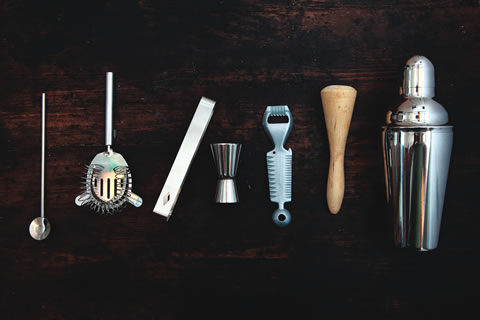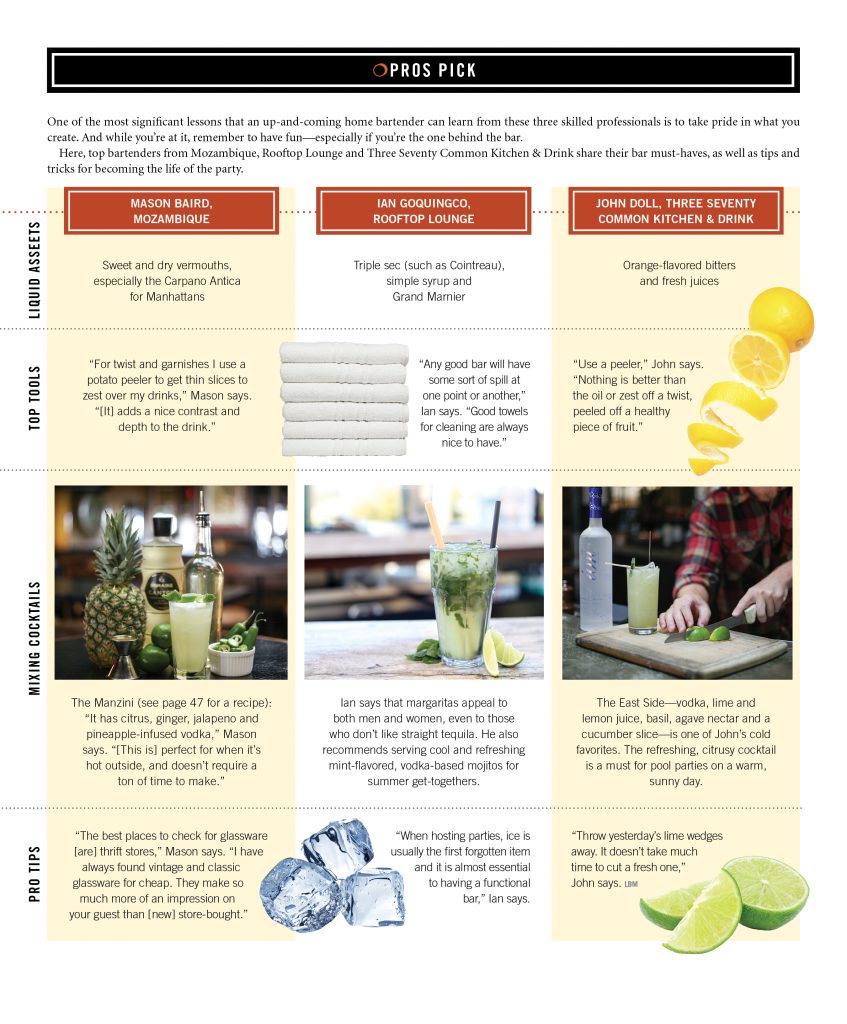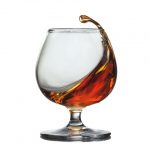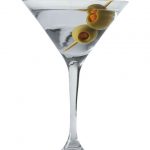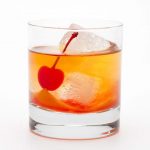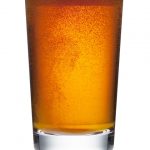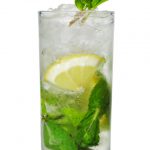Whether you want to impress guests or just re-create your favorite drink, the ability to expertly craft a cocktail will never go out of style.
By Peter A. Balaskas and Allison Hata
Setting the Scene
The first step in establishing any kind of lounge or bar environment is creating a base of operations—a place where the bar and contents are conveniently located.
Orange County-based interior designer Shala Shamardi says homeowners should first look at the aesthetics of the surrounding areas. As a bar often becomes a gathering space within a residence, it’s important to consider location. If you’re building a bar between two rooms, make sure design choices feel like a natural extension of the home, she explains.
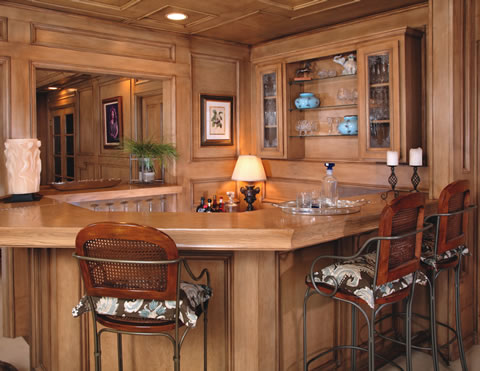
Custom built-ins, like cabinets and a sturdy countertop, are a great splurge for making a bar feel like it belongs in the home; however, those interested in a more do-it-yourself approach can carve out a smaller space for less using vintage finds.
Mason Baird, bartender at Mozambique, says that pre-owned home bars can be purchased for economical prices at venues like the Rose Bowl flea market in Pasadena or at local residential sales. “An old roommate and friend … found a sweet vintage midcentury green and gold bar at a yard sale that got turned into the neighborhood bar,” he says. “I think she bought it for less than $200.”
In lieu of a fixed piece of furniture, bartender John Doll of Three Seventy Common Kitchen & Drink suggests a movable bar cart for spirits that don’t need to be refrigerated, as well as bar tools and specialty glasses.
“If you aren’t able to have a dedicated space, just make sure you know where everything you need is,” he adds. “Keep your glasses and equipment clean and handy, have a supply of cocktail napkins and swizzle sticks, and you’ll want to have your favorite recipes/bartending guide on hand.”
That train of thought applies to one overarching piece of design advice from Shala: Keep the space ergonomically functional. Speaking from personal experience, Rooftop Lounge mixologist Ian Goquingco cites a designated area for ice as the key to a successful bar. In addition, open cabinets or shelves that display glassware or liquor bottles are a useful feature that plays to both aesthetics and practicality, as the items are easily accessible.
Tools of the Trade
Getting the proper tools makes all the difference when it comes to making a drink. Ian says that a mixing pint and shaker are essential, in addition to a host of other foreign-looking objects that allow you to make cocktails like a pro.
Strainers are important for those who use Boston shakers; a Hawthorne strainer fits on top of the metal can and can help filter ice and seeds. Fine mesh strainers work better for drinks that call for muddling ingredients, Mason explains.
He also suggests a heavy wood muddler, a pestle-like instrument used to extract oils and other flavors from specific ingredients like fruit. “The plastic muddlers tend to tear the ingredients into shreds rather than just releasing the oils,” he says.
A jigger to measure alcohol, a cocktail spoon for stirring and a knife round out the basics needed for any home bar.
Standard shakers come in three pieces (a can, a lid with a strainer and a cap), while Boston shakers have a tapered can and a 16-ounce glass. If you’re planning to entertain large groups, opt for the latter, as they allow for more drinks to be mixed at once.
It’s All in the Wrist
The right equipment is only helpful if you know how to handle it. In general, an all-alcohol cocktail is stirred to preserve the texture, as it’s a drink that’s meant to be sipped. Drinks with fruit juice, sweeteners or egg whites are shaken to chill and dilute. Shaking cocktails introduces air bubbles into the liquid, which creates a frothy appearance for sweet drinks and a foamy head on those with egg whites.
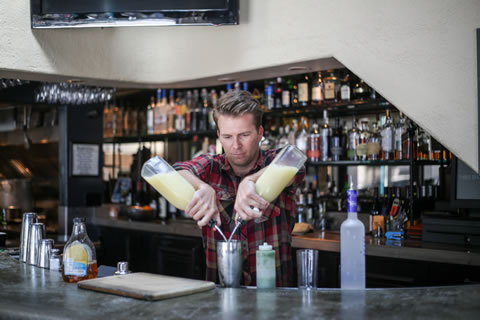
John is partial to building a drink, where the host prepares the beverage directly into the serving glass. He feels that layering plays an important part in a bartender’s learning curve. “This is when you want to float an ingredient on top of another ingredient,” John says. “It’s a little more complicated because you’ll need to know the different weights of the alcohols.”
Liqueurs and liquors of different densities stay separated in a glass with a steady pour; start with the most dense, sugary options at the bottom and pour each subsequent layer slowly over the back of a bar spoon to create a colorful drink.
Getting the Right Glass
The vessels for holding a cold cocktail are seemingly endless. Here are a few standard styles recommended by bartending pros Ian, John and Mason.
Manzini
Servings: 1
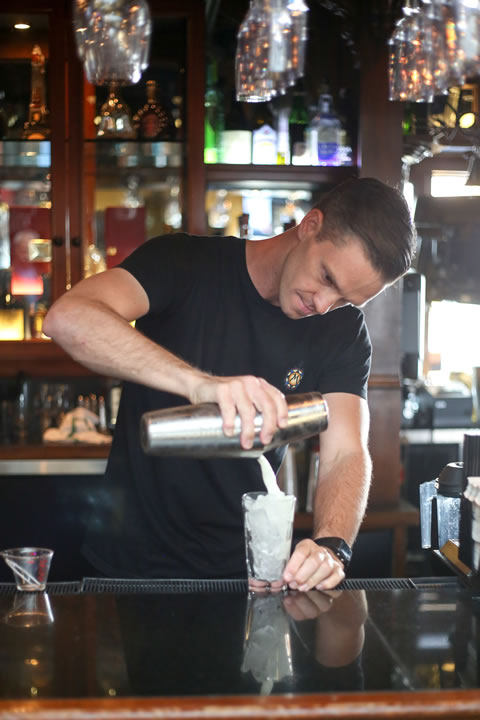
1 ounce ginger simple syrup (see below)
¼ ounce fresh lime juice
2 slices fresh jalapeno
1 splash pineapple juice
2 ounces pineapple-infused vodka
Ice, as needed
Add all ingredients into a shaker and shake vigorously until the outside is ice cold; strain over fresh ice into a tall glass and garnish with a lime twist.
Ginger simple syrup:
¾ cup sugar
¼ cup peeled and chopped fresh ginger
¾ cup water
Combine all ingredients in a saucepan and bring to a boil, stirring until the sugar has dissolved. Remove from heat and let sit for 30 minutes. Strain into a jar, cover and chill.
(Recipe from Mason Baird, Mozambique)


